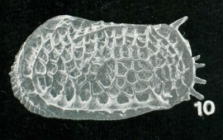Ostracoda taxon details
Bradleya lordhowensis Whatley, Downing, Kesler & Harlow, 1984
461422 (urn:lsid:marinespecies.org:taxname:461422)
accepted
Species
marine, fresh, terrestrial
Whatley, R.C., Downing, S.E., Kesler, K. and Harlow, C.J. (1984a) New species of the ostracod genus Bradleya from the Tertiary and Quaternary of D.S.P.D.P. sites in the southwest Pacific. Revista Espanola de Micropaleontologia 16, 265–298. [details]
Type locality contained in Lord Howe Rise
type locality contained in Lord Howe Rise [details]
Description Medium, moderately thin-shelled. Sub-rectangular to quadrate. Anterior regular convex and densely denticulate; extremity...
Etymology L. Alluding to the apparent restriction of this species to the Lord Howe Rise.
Description Medium, moderately thin-shelled. Sub-rectangular to quadrate. Anterior regular convex and densely denticulate; extremity below midheight. Posterior bluntly convex with posterodorsal concavity in RV only; aproximately six long marginal denticles. Dorsal margin straight with anterior hinge ear and large posterodorsal spine in LV only. Ventral margin straigh tto slightly sinuous. Maximum length below mid-height, maximum height at anterior cardinal angle. Reticulum rather low. Ventrolateral ridge strong and straight with large spine at its postero termination; extending anteriorly into a rather weaker ocular ridge which is always parallel to the anterior margin. Dorsal ridge weak, narrow and flange-like, nonspinose. Bridge very low, suppressed. Remainder of reticulum rather low, irregular and evenly expressed over entire valve surface. Muri narrow sharply emphasized. Fossae rather small, secondarily reticulate. Densely foveolate. Solar pores often connulate. Blind. Internal features as for the genus. [details]
Etymology L. Alluding to the apparent restriction of this species to the Lord Howe Rise.
Etymology L. Alluding to the apparent restriction of this species to the Lord Howe Rise. [details]
Brandão, S.N.; Antonietto, L.S; Nery, D.G.; Pereira, J.S.; Praxedes, R.A.; Santos, S.G.; Karanovic, I. (2024). World Ostracoda Database. Bradleya lordhowensis Whatley, Downing, Kesler & Harlow, 1984. Accessed at: https://www.marinespecies.org/Ostracoda/aphia.php?p=taxdetails&id=461422 on 2024-11-15
Date
action
by
original description
Whatley, R.C., Downing, S.E., Kesler, K. and Harlow, C.J. (1984a) New species of the ostracod genus Bradleya from the Tertiary and Quaternary of D.S.P.D.P. sites in the southwest Pacific. Revista Espanola de Micropaleontologia 16, 265–298. [details]
basis of record Webber, W.R., G.D. Fenwick, J.M. Bradford-Grieve, S.G. Eagar, J.S. Buckeridge, G.C.B. Poore, E.W. Dawson, L. Watling, J.B. Jones, J.B.J. Wells, N.L. Bruce, S.T. Ahyong, K. Larsen, M.A. Chapman, J. Olesen, J.S. Ho, J.D. Green, R.J. Shiel, C.E.F. Rocha, A. Lörz, G.J. Bird & W.A. Charleston. (2010). Phylum Arthropoda Subphylum Crustacea: shrimps, crabs, lobsters, barnacles, slaters, and kin. <em>in: Gordon, D.P. (Ed.) (2010). New Zealand inventory of biodiversity: 2. Kingdom Animalia: Chaetognatha, Ecdysozoa, Ichnofossils.</em> pp. 98-232 (COPEPODS 21 pp.). [details] Available for editors [request]
[request]
basis of record Webber, W.R., G.D. Fenwick, J.M. Bradford-Grieve, S.G. Eagar, J.S. Buckeridge, G.C.B. Poore, E.W. Dawson, L. Watling, J.B. Jones, J.B.J. Wells, N.L. Bruce, S.T. Ahyong, K. Larsen, M.A. Chapman, J. Olesen, J.S. Ho, J.D. Green, R.J. Shiel, C.E.F. Rocha, A. Lörz, G.J. Bird & W.A. Charleston. (2010). Phylum Arthropoda Subphylum Crustacea: shrimps, crabs, lobsters, barnacles, slaters, and kin. <em>in: Gordon, D.P. (Ed.) (2010). New Zealand inventory of biodiversity: 2. Kingdom Animalia: Chaetognatha, Ecdysozoa, Ichnofossils.</em> pp. 98-232 (COPEPODS 21 pp.). [details] Available for editors
 Present
Present  Inaccurate
Inaccurate  Introduced: alien
Introduced: alien  Containing type locality
Containing type locality
From editor or global species database
Description Medium, moderately thin-shelled. Sub-rectangular to quadrate. Anterior regular convex and densely denticulate; extremity below midheight. Posterior bluntly convex with posterodorsal concavity in RV only; aproximately six long marginal denticles. Dorsal margin straight with anterior hinge ear and large posterodorsal spine in LV only. Ventral margin straigh tto slightly sinuous. Maximum length below mid-height, maximum height at anterior cardinal angle. Reticulum rather low. Ventrolateral ridge strong and straight with large spine at its postero termination; extending anteriorly into a rather weaker ocular ridge which is always parallel to the anterior margin. Dorsal ridge weak, narrow and flange-like, nonspinose. Bridge very low, suppressed. Remainder of reticulum rather low, irregular and evenly expressed over entire valve surface. Muri narrow sharply emphasized. Fossae rather small, secondarily reticulate. Densely foveolate. Solar pores often connulate. Blind. Internal features as for the genus. [details]Diagnosis Medium, rather weakly calcified. Sub-rectangular to quadrate. Ventro-Iateral ridge strong, straight with large spine at its posterior termination; extending forward to a rather weak WHATLEY et aI. ocular ridge parallel to interior margin. Remainder of reticulum low, irregular, evenly expressed over entire valve. Muri low but sharply emphasized; fossae shallow, secondarily reticulate. Densely foveolate. Bridge very low and suppressed. Blind. [details]
Etymology L. Alluding to the apparent restriction of this species to the Lord Howe Rise. [details]

